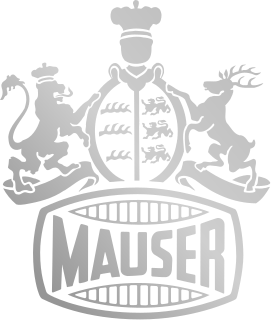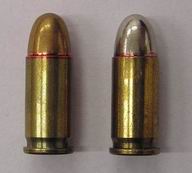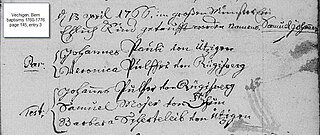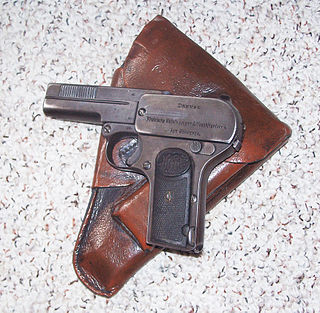
The percussion cap or percussion primer, introduced in the early 1820s, is a type of single-use percussion ignition device for muzzleloader firearm locks enabling them to fire reliably in any weather condition. This crucial invention gave rise to the caplock mechanism or percussion lock system using percussion caps struck by the hammer to set off the gunpowder charge in percussion guns including percussion rifles and cap and ball firearms. Any firearm using a caplock mechanism is a percussion gun. Any long gun with a caplock mechanism and rifled barrel is a percussion rifle. Cap and ball describes caplock firearms discharging a single bore-diameter spherical bullet with each shot.

Bolt action is a type of firearm action where the handling of cartridges into and out of the weapon's barrel chamber is operated by manually manipulating the bolt directly via a bolt handle, which is most commonly placed on the right-hand side of the weapon. When the handle is operated, the bolt is unlocked from the receiver and pulled rearward to open the breech allowing the spent cartridge case to be extracted and ejected, the firing pin within the bolt is cocked and engages the sear, then upon the bolt being pushed back, a new cartridge is loaded into the chamber, and finally the breech is closed tight by the bolt re-locking against the receiver.

The Chassepot, officially known as Fusil modèle 1866, was a bolt action military breechloading rifle, famous as the arm of the French forces in the Franco-Prussian War of 1870–1871. It replaced an assortment of Minié muzzleloading rifles many of which were converted in 1864 to breech loading. A great improvement to existing military rifles in 1866, the Chassepot marked the commencement of the era of modern bolt action, breech-loading military rifles. Beginning in 1874, the rifle was easily converted to fire metallic cartridges, a step which would have been impossible to achieve with the Dreyse needle rifle.

Mauser, originally Königliche Waffen Schmieden, is a German arms manufacturer. Their line of bolt-action rifles and semi-automatic pistols has been produced since the 1870s for the German armed forces. In the late 19th and early 20th centuries, Mauser designs were also exported and licensed to many countries which adopted them as military and civilian sporting firearms. The Mauser Model 98 in particular was widely adopted and copied, and is the foundation of many of today's sporting bolt action rifles.
A semi-automatic firearm, also called self-loading firearm or autoloading firearm, is one whose action mechanism automatically loads a following round of cartridge into the chamber (self-loading) and prepares it for subsequent firing, but requires the shooter to manually actuate the trigger in order to discharge each shot. Typically, this involves the weapon's action utilizing the excess energy released during the preceding shot to unlock and move the bolt, extracting and ejecting the spent cartridge case from the chamber, re-cocking the firing mechanism, and loading a new cartridge into the firing chamber, all without input from the user. To fire again, however, the user must exert effort to actively release the trigger, allow it to "reset", before pulling the trigger again to fire off the next round. As a result, each trigger-pull only discharges a single round from a semi-automatic weapon, as opposed to a fully automatic weapon, which will shoot continuously as long as the ammunitions are replete and the trigger is kept depressed.

A breechloader is a firearm in which the user loads the ammunition via the rear (breech) end of its barrel, as opposed to a muzzleloader, which loads ammunition via the front (muzzle) end.

.32 ACP is a centerfire pistol cartridge. It is a semi-rimmed, straight-walled cartridge developed by firearms designer John Browning, initially for use in the FN M1900 semi-automatic pistol. It was introduced in 1899 by Fabrique Nationale, and is also known as the 7.65×17mmSR Browning or 7.65 mm Browning Short.

Sömmerda is a town near Erfurt in Thuringia, Germany, on the Unstrut river. It is the capital of the district of Sömmerda.

The Dreyse needle-gun was a military breechloading rifle. It is famous for having been the main infantry weapon of the Prussians, who accepted it for service in 1841 as the "leichtes Perkussionsgewehr Model 1841"("light percussion rifle Model 1841"), with the name chosen to hide the revolutionary nature of the new weapon. The name "Zündnadelgewehr"/"needle-gun" comes from its needle-like firing pin, which passed through the paper cartridge case to strike a percussion cap at the bullet base. The Dreyse rifle was also the first breech-loading rifle to use the bolt action to open and close the chamber, executed by turning and pulling a bolt handle. It has a rate of fire of about 6 rounds per minute.

Johann Nicolaus von Dreyse was a German firearms inventor and manufacturer. He is most famous for submitting the Dreyse needle gun in 1836 to the Prussian army, which was adopted for service in December 1840 as the Leichte Perkussions-Gewehr M 1841 – a name deliberately chosen to mislead about the rifle's mechanism – later renamed Zündnadelgewehr M 1841 in 1855.

Rotating bolt is a method of locking the breech of a firearm closed for firing. Johann Nicolaus von Dreyse developed the first rotating bolt firearm, the "Dreyse needle gun", in 1836. The Dreyse locked using the bolt handle rather than lugs on the bolt head like the Mauser M 98 or M16. The first rotating bolt rifle with two lugs on the bolt head was the Lebel Model 1886 rifle. The concept has been implemented on most firearms chambered for high powered cartridges since the 20th century.

The MG 13 is a German light machine gun developed by converting the Dreyse Model 1918 heavy water-cooled machine gun into an air-cooled version.

The Mauser Model 1871 adopted as the Gewehr 71 or Infanterie-Gewehr 71, or "Infantry Rifle 71" was the first rifle model in a distinguished line designed and manufactured by Paul Mauser and Wilhelm Mauser of the Mauser company and later mass-produced at Spandau arsenal.

Jean Samuel Pauly, born Samuel Johannes Pauli, was a Swiss inventor and gunsmith of the early 19th century. Parish records show that he was baptised in Vechigen near Bern, Switzerland on 13 April 1766, the son of Johann Pauli and Veronika Christine.

The Dreyse Model 1907 is a semi-automatic pistol designed by Louis Schmeisser. The gun was named after Nikolaus von Dreyse, the designer of the Dreyse Needle Gun. The Waffenfabrik von Dreyse company was acquired by Rheinische Metallwaren & Maschinenfabrik Sömmerda in 1901, although the Dreyse Model pistols were marketed under the Dreyse name.
A needle gun is a firearm that has a needle-like firing pin, which can pass through the paper cartridge case to strike a percussion cap at the bullet base.

The Königlich Württembergische Gewehrfabrik was a state owned firearms manufacturer from 1812 to 1874 and the predecessor of the Mauser arms manufacturer.
The Battle of Hühnerwasser was the first battle of the Austro-Prussian War. It was the first engagement in the opening days of the Königgrätz campaign, fought in Bohemia on 26 June 1866. It was fought between troops of the Prussian Elbe army under General Herwarth von Bittenfeld and troops from the Austrian I Corps, led by Leopold Gondrecourt.
The Podewils gun was a 13.9mm calibre rifle used in the Bavarian army since 1858. It was the most common infantry weapon of the Bavarian army in the Austro-Prussian war of 1866 and the Franco-Prussian war of 1870/71. Theodor Fontane called it an "excellent" weapon of the Austro-Prussian war due to its long range. Originally a muzzleloader, it was converted to breechloading in 1867, the so-called Lindner conversion. In 1869 the Bavarian army started to replace it with the Werder breechloader, but due to budgetary constrains by 1870 most Bavarian troops still used the Podewils while only four infantry battalions had received the Werder. Even the Lindner conversion was inferior to both the Prussian Dreyse needle gun and the French Chassepot.
Events from the year 1867 in Germany.














